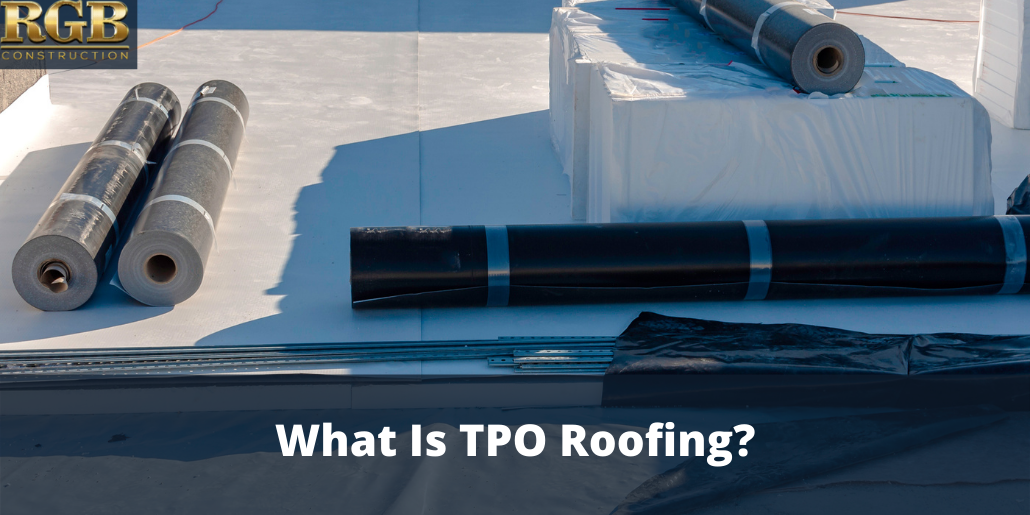It’s fairly commonplace to connect TPO roofing with those stark, bright, and amazingly white rooftops you’ve seen hundreds of examples of in industrial parks across the country. Yes, that’s likely TPO, a commonly used single-ply roofing material that has become popular in commercial roofing design. So, in more precise terms, what is single-ply and TPO roofing, and what are their differences?
Single-Ply Membranes
Single-ply membranes are synthetic as well as rubber in their makeup. To adhere these membranes to a flat roof, they are either fastened mechanically, ballasted to a roof, or affixed to the insulation that forms a protective layer on a flat roof surface.
Single-ply is a commonly known type of commercial material. However, you might not know that there are two types of single-ply membranes made to suit both the budgets and the building needs of commercial operations. Those types include:
- Thermoplastic Polyolefin (TPO)
- Ethylene Propylene Diene Terpolymer (EPDM)
Both of these single-ply membranes vary in their material content, their energy efficiency, and their installation methods.
TPO Roofing
In scientific jargon, TPO translates to Thermoplastic Polyolefin. It is categorized as a layer of a single-ply membrane composed of synthetic components along with a fabric reinforcing scrim that stabilizes and strengthens the membrane for improved and increased performance. It consists of a smattering of different rubber types that are usually a combination of polypropylene and ethylene-propylene rubber.
TPO has gained considerable use with commercial roofing systems, particularly in covering flat roofs. It’s doubly sought after for its natural reflective ability to deflect ultraviolet waves (UV) while conserving energy and saving on utility costs.
The manufacturer fabricates the membranes themselves in sheet form, and they measure in widths of 10, 12, and 20 feet. Once cut, rolled, and assembled, the manufacturer distributes the sheets to the facility that requests and purchases the materials for commercial roofing purposes.
How TPO is Installed
Once you prepare, clean, or remove the substrate (or the surface on which the TPO membrane is going to be affixed), put the new insulation in place. There are choices or options with insulation that include:
- Polyiso or Polyisocyanurate – one of the most often used insulation types for roofing applications. It can be costly but has a high R-value rating, which is a measurement of a material’s resistance to the flow of heat. This top rating means that the insulation has a strong ability to withstand heat.
- EPS or Expanded Polystyrene – this insulation has one of the highest R-values and is used in roofing as well as for floor and wall insulation. It is resistant to water, and you can use it when contact or connection to the ground is part of the insulation process.
- (XPS) Extruded Polystyrene – This type of insulation is characterized by its colors, which are pink, blue, or green. Its performance and cost are in a range between the Polyiso and EPS. It is a semipermeable material that has a perm rating of 1. A perm rating is a measurement that gives the rate of water vapor that flows through a square foot of material. A high perm rating equates to a more significant amount of water vapor passing through a roofing or other material. A lower score, such as 1, equates to a smaller amount of water vapor passing through a roofing or other material.
TPO Attachment/Adherence
A TPO membrane is either mechanically fastened or affixed through an adhesive that bonds to the cover board. Once the membrane has been rolled into place, the seams created are welded together with a hot-air type gun.
TPO Costs
There are factors to consider when it comes to the overall costs of single-ply materials and their installation. Though a reasonably inexpensive material to use, there are considerations to be made to obtain the best material at a fair price. To get a cost-effective solution, take the following should into account:
- Roof condition
- Roof size
- Roof access
- Insulation selection
- Membrane selection
- Installation options
- Roof protrusions/penetrations
- Warranty options
Benefits of TPO
With the proper maintenance and installation, single-ply membrane roofing can last from 10-20 years. There are other benefits with single-ply systems, such as:
- Insulation choices – Single-ply roofing systems exclude the insulation factor, so as a commercial roofing consumer, you have various options to select from for insulating a commercial roof.
- Installation choices – There are choices for how you can install a single-ply roof. It can be fastened or attached right to a roof deck, as well as affixed with different adhesives. It can even be welded through the heat in more difficult spots on a roof, such as areas where protrusions, projections, and chimneys are present.
- Resists Corrosion – TPO is resistant to corrosion and disintegration when it comes in contact with various materials. It is also resistant to mildew and algae and doesn’t necessitate pressure washing, so it is easy to maintain.
- Fire-Rated, Class A – Both TPO and EPDM membranes are Class A fire-resistant. During the production process, the manufacturer adds fire retardant chemicals to the composition of the material.
- Reflective and Penetrable – Most TPO is usually white and extremely reflective. While in contrast, EDPM is often black because of the membrane’s natural color and its retention of the sun’s rays.
Savings with TPO
Single-ply membrane roofing has become one of the top roofing materials for most commercial facilities. There are savings to be had in its cost-effectiveness for businesses almost anywhere.
With the bright white reflective attributes of TPO, there is money to be saved on energy usage during the warmest months of the year. Utility consumption lessens, while the interior of a building remains cool.
Disadvantages of TPO
Though TPO can be fairly inexpensive, many TPO products are considerably different in quality and construction. The product’s broad range of thicknesses can be a problem as consumers somehow get the idea that a thicker TPO is better quality and longer-lasting. Thickness doesn’t have a whole lot to do with the strength and durability of the material. So, in spite of thickness, different TPO products weaken and deteriorate to the same degree.
In addition, the various compounds in TPO have changed over the years, which has made it challenging to determine precisely how long a single-ply TPO roof is going to last. An overall estimate puts the life of this type of roof at 10-20 years. The limited durability appears to be associated with the laminating process on the top layer of TPO products. This process can produce weak spots that cause disintegration as well as surface cracking and splitting.
Another problem with TPO is the width of its rolls, as they tend to be small in their width. This can cause problems with additional seams at various intervals on the roof’s surface. These seams can cause difficulties when it comes to membrane expansion and contraction. Seams can loosen, and water can get into vulnerable areas of a roof.
Weighing the advantages and disadvantages of TPO doesn’t have to be a mind-boggling experience. You just need to spend a little time researching various manufacturers, their performance history, and what guarantees and warranties they offer. If you have further questions concerning TPO, simply complete the online contact form. A representative will get back to you with the answers you need to decide whether TPO is the way to go for your commercial roofing needs.








